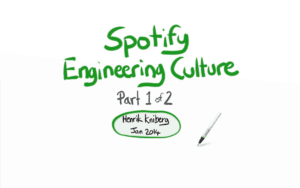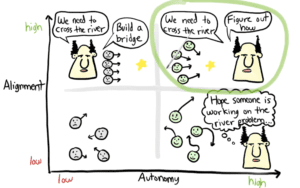 A company that has really piqued my interest in the new year has been Spotify and the way they operate. In doing a bit of digging into their culture I came across a couple of videos by Henrik Kniberg, which are a fascinating behind-the-scenes insight into the way one of the world’s most popular tech platforms operates. For anyone that’s interested in the culture of a high growth tech company I highly recommend you spend 30 minutes checking out these videos (these videos are now a few years old, however the lessons from them are 100% still as relevant in 2019).
A company that has really piqued my interest in the new year has been Spotify and the way they operate. In doing a bit of digging into their culture I came across a couple of videos by Henrik Kniberg, which are a fascinating behind-the-scenes insight into the way one of the world’s most popular tech platforms operates. For anyone that’s interested in the culture of a high growth tech company I highly recommend you spend 30 minutes checking out these videos (these videos are now a few years old, however the lessons from them are 100% still as relevant in 2019).
Spotify Engineering Culture (part 1)
Naturally given what we do here at There Be Giants, these videos sparked one dominant question for me – how would OKRs and the TBG methodology fit into the Spotify Engineering Culture?
To answer this question I’m going to write separate blogs on the three main stories I pulled out of Henrik’s videos and how OKRs can help with these:
- People & Culture
- Process
- Support for Growing Pains
So, to get us started, let’s talk about People & Culture.
If you’ve ever spoken to me regarding Leadership, you will know that the People within a business and the Culture that is being curated within the teams are the number one most important thing to me. These are even the two main factors that led me to become part of There Be Giants, as I know the work we do makes such a positive impact on not only a business’ growth plans but also the everyday employee who is needed to execute these plans on a daily basis.
This diagram from Henrik’s video is a perfect snapshot of exactly what Spotify are aiming for from their staff and their culture
 In other words, High Alignment and High Autonomy creates the ultimate conditions for their employees to thrive. So, how can OKRs help create such an environment within a workplace? Well, OKRs by their very nature are (or at least should be!) crafted to be top down and bottom up, so a Leader will be able to provide the content for a priority that needs completing, whilst the team are left to come up with the ways in which they will align under this priority and to come up with the Key Results that will show they have achieved this. So the OKR for this may end up looking a little like this —
In other words, High Alignment and High Autonomy creates the ultimate conditions for their employees to thrive. So, how can OKRs help create such an environment within a workplace? Well, OKRs by their very nature are (or at least should be!) crafted to be top down and bottom up, so a Leader will be able to provide the content for a priority that needs completing, whilst the team are left to come up with the ways in which they will align under this priority and to come up with the Key Results that will show they have achieved this. So the OKR for this may end up looking a little like this —
Objective: We need to cross this river so that we can farm our crops on more fertile fields
KR: 50% fewer deaths from starvation
KR: 25% higher income from crops sold at local farmers market
KR: 75% decrease in customer complaints about lack of stock
How they achieve these KRs and Objectives are up to the team to decide within their resources; should they build a bridge? Should they build a raft? Should they build a slingshot to throw themselves across? That’s up to them.
Now an OKR like the one above would also be relevant to another of Spotify’s principles, to have cross-functional, autonomous squads. As Henrik says in his video, the Leader’s job is to inform his team on what problem needs to be solved & why, the squad’s job is to collaborate with each other to find the best solution. On that note, let’s take a look at what Spotify mean by Squads and the other ways they organise their people.

Spotify are on board with having different ‘community’ names for their different internal groups they have squads (the vertical columns on the above diagram) which are groups of staff made up from different parts of the business all working together to achieve a type of project. They have have Tribes which are a larger section of the business, perhaps a specific office, etc. Chapters are within a Tribe and all work on the same aspect of the business, whether it’s Dev or Marketing, etc. Then there are the Guilds which could be made up of anyone, anywhere but all of whom have a common interest and regularly get together and communicate to discuss that interest.
The main values that supports all of this though is that Spotify believe in having autonomous, cross-functional squads that are loosely coupled and tightly aligned. As you can see in the screenshot above, they value community over a hierarchical structure and trust over control. In their eyes, No Politics = No Fear and if there is no fear then their staff aren’t afraid to fail. This type of culture is one of the main things we at There Be Giants advocate for OKR success. We are very much on board with Spotify that failure is okay, as long as you Fail Fast, Learn Fast & Improve Fast. This is exactly what the sprints in our OKR methodology allow you to do, and if something does go wrong then it’s only a problem if you don’t learn from it. A massive part of OKR routines are retrospectives, what happened? what did we learn? what will we change? As long as you keep on answering these questions the company will grow at an exhilarating rate, and if you want to read more about the impact of retrospectives on a couple of our clients, then check out this blog

